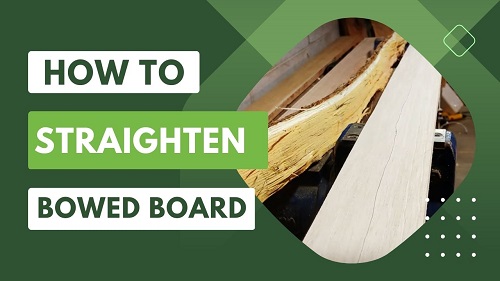A bowed 4×4 post is a common issue faced by property owners, particularly those with wooden fences, decks, or pergolas. These posts, which have undergone warping or bending over time, can compromise the structural integrity of the entire structure.
This article aims to provide you with a step-by-step guide on how to straighten a bowed 4×4 post effectively.
To straighten a bowed 4×4 post, you can apply moisture and heat or utilize tensioning methods like ratchet straps. For severe bows, hydraulic jacks or mechanical straightening devices are recommended.
How to straighten a warped 4×4 fence post?
To straighten a warped 4×4 fence post, you can use a hydraulic jack to apply pressure and gradually push the post back into a straight position. Monitor the alignment using a level and make adjustments as necessary.
Common Causes
Moisture and Weather Effects
One of the primary reasons for a bowed 4×4 post is moisture. When exposed to rain, snow, or high humidity, the wood can absorb moisture, causing it to expand and eventually warp. Over time, this repeated cycle of wetting and drying can lead to severe bowing.
Improper Installation
Another common cause of bowed 4×4 posts is improper installation. If the post wasn’t set correctly during the initial construction, it may start bowing as it bears the weight of the structure above. Insufficient anchoring or poor alignment can contribute to the post’s instability.
Wood Quality
The quality of the wood used for the post can also play a role in its susceptibility to bowing. Low-quality or poorly seasoned wood is more likely to warp and deform over time, leading to a bowed post.
Natural Aging and Settling
As wood ages, it goes through a natural process of drying, shrinking, and settling. This natural aging process can cause the post to develop a bow or warp as it adjusts to the environmental conditions.
This effect is more pronounced if the wood was not properly dried or seasoned before use.
Excessive Load or Pressure
If a 4×4 post is subjected to excessive load or pressure, such as heavy snow accumulation, strong winds, or leaning structures, it can cause the post to bend or bow.
Over time, this continued stress on the post can result in significant bowing.
Inadequate Maintenance
Lack of regular maintenance, such as sealing or staining the wood, can make the post more susceptible to moisture absorption and subsequent warping. Proper maintenance helps protect the wood from the effects of weather and prevents bowing.
Assessing the Severity of the Bow
Before proceeding with the straightening process, it’s essential to assess the severity of the bow. This assessment will help you determine the best course of action and the level of effort required to rectify the problem.
Begin by conducting a visual inspection of the post. Look for obvious signs of bowing, such as a noticeable curve or leaning.
Next, measure the degree of bow using a measuring tape or a string and a level. This measurement will serve as a baseline to track your progress during the straightening process.
Preparing the Necessary Tools and Materials
- Personal Protective Equipment (PPE):
- Safety glasses
- Work gloves
- Moisture and Heat Application:
- Hose or steam generator for applying moisture
- Heat gun or blow torch for applying heat (with caution)
- Tensioning Methods:
- Ratchet straps
- Cables or ropes for applying tension
- Hydraulic Jacks:
- Hydraulic jacks for exerting controlled pressure
- Wooden blocks or shims for supporting the post
- Mechanical Straightening Devices:
- Post pullers
- Come-alongs or winches for mechanical straightening
- Fasteners and Brackets:
- Nails or screws for securing components
- Metal brackets for additional support and stability
- Measuring Tools:
- Measuring tape for assessing bow severity
- Level for checking alignment
- Miscellaneous Tools:
- Hammer
- Pry bar or crowbar for removing attached components
- Saw or reciprocating saw for cutting if necessary
Straightening Techniques for a Bowed 4×4 Post
| Technique | Description | Difficulty Level | Cost | Best for |
|---|---|---|---|---|
| Moisture and Heat | Applying moisture and heat to encourage expansion of wood fibers. | Moderate | Low | Mild to moderate bows |
| Tensioning Methods | Applying tension using ratchet straps or cables to gradually straighten the post. | Moderate | Low | Moderate bows |
| Hydraulic Jacks | Utilizing hydraulic jacks to exert controlled pressure for precise straightening. | Difficult | Moderate | Severe bows |
| Mechanical Straightening Devices | Using post pullers or come-alongs to mechanically pull and straighten the post. | Difficult | High | Stubborn or complex bows |
One of our articles –How to Straighten Warped 2×6?
There are various techniques you can employ to straighten a bowed 4×4 post. Let’s explore some of the most commonly used methods:
Applying Moisture and Heat
One method to straighten a bowed 4×4 post is by applying moisture and heat. By wetting the concave side of the bow and exposing it to heat, you can encourage the wood fibers to expand, helping to correct the bow.
Take care not to overheat the wood, as it can cause damage or even ignite.
Using Tensioning Methods
Tensioning methods involve applying force to the bowed post to gradually straighten it. Ratchet straps or cables can be used to create tension by securing them to the post and applying pressure in the opposite direction of the bow.
This method can be effective for moderate bows.
Utilizing Hydraulic Jacks
Hydraulic jacks are another powerful tool for straightening a bowed 4×4 post. By placing the jacks strategically, you can apply controlled pressure to specific areas of the post, gradually correcting the bow.
This method is particularly useful for severe bows.
Implementing Mechanical Straightening Devices
Mechanical straightening devices, such as post pullers or come-alongs, can provide precise and powerful straightening force.
These devices utilize mechanical advantage to pull the post into the desired position, rectifying the bow.
They are especially beneficial when dealing with stubborn or complex bows.
One of our articles –How to Straighten a Bowed Board?
Step-by-Step Process to Straighten a Bowed 4×4 Post
Now that you are familiar with the various straightening techniques, let’s outline a step-by-step process to straighten a bowed 4×4 post:
- Step 1: Assessing the Bow Severity
- Inspect the post visually to determine the extent of the bow.
- Measure the degree of bow using a measuring tape or string and level.
- Step 2: Loosening Any Attached Components
- Remove any attached components such as brackets or fasteners to facilitate the straightening process.
- Step 3: Applying Moisture and Heat
- Wet the concave side of the bow using a hose or steam generator.
- Apply heat to the wetted area using a heat gun or blowtorch, taking caution not to overheat.
- Step 4: Utilizing Tensioning Methods
- Secure ratchet straps or cables to the post and apply tension in the opposite direction of the bow.
- Gradually increase the tension until the desired straightness is achieved.
- Step 5: Straightening with Hydraulic Jacks
- Position hydraulic jacks strategically around the bowed post.
- Gradually apply pressure using the jacks to straighten the post incrementally.
- Step 6: Implementing Mechanical Straightening Devices
- Attach mechanical straightening devices such as post pullers or come-alongs to the post.
- Utilize the mechanical advantage of these devices to exert force and straighten the post.
- Step 7: Securing the Post in the Corrected Position
- Once the desired straightness is achieved, secure the post using appropriate fasteners and brackets.
- Double-check the post’s alignment and stability before considering the job complete.
Post-Straightening Considerations and Maintenance
After straightening a bowed 4×4 post, it’s crucial to reinforce its structural integrity to prevent future bowing.
Consider adding additional support, such as brackets or diagonal braces, to provide extra stability.
Regularly monitor the post for any signs of bowing or movement and make adjustments as necessary.
Frequently Asked Questions
Can I straighten a severely bowed 4×4 post without replacement?
Yes, it is possible to straighten a severely bowed 4×4 post using techniques such as hydraulic jacks or mechanical straightening devices.
However, if the post is structurally compromised or the bow is beyond repair, replacement may be necessary.
Is it necessary to remove the post from the ground to straighten it?
In most cases, you can straighten a bowed 4×4 post without removing it from the ground. However, if the bow is severe or the post cannot be adequately accessed, removing it may be required.
How long does it take to straighten a bowed 4×4 post?
The time required to straighten a bowed 4×4 post depends on various factors, including the severity of the bow, the chosen technique, and the individual’s experience. It can range from a few hours to a full day.
Can I use heat alone to straighten the post?
While heat can be effective in straightening a bowed 4×4 post, it is usually combined with other techniques such as tensioning methods or hydraulic jacks for optimal results.
What should I do if the post keeps bowing after straightening?
If the post continues to bow after straightening, it may indicate underlying issues such as unstable ground conditions or improper support.
Reassess the installation and consider consulting a professional for further assistance.
Should I consult a professional for post straightening?
If you are unsure about the straightening process or if the bow is severe, it is recommended to consult a professional contractor or structural engineer.
They can provide expert guidance and ensure the job is done safely and effectively.
Can I prevent a 4×4 post from bowing in the first place?
While it is challenging to completely prevent wood from bowing, some preventive measures can minimize the likelihood.
These include using pressure-treated wood, properly sealing the post, and ensuring correct installation techniques, such as proper curing of the surrounding concrete.
What are the signs of a structurally compromised 4×4 post?
Signs of a structurally compromised 4×4 post may include excessive bowing, splitting, cracking, or visible signs of decay.
If you notice any of these signs, it is advisable to consult a professional for an accurate assessment and appropriate course of action.
Conclusion
Straightening a bowed 4×4 post is a task that requires patience, attention to detail, and the right tools.
By following the outlined techniques and steps, you can successfully restore the structural stability and aesthetic appeal of your post.
Remember to prioritize safety throughout the process and seek professional assistance if needed.








